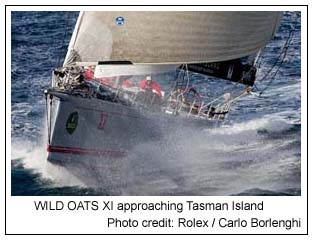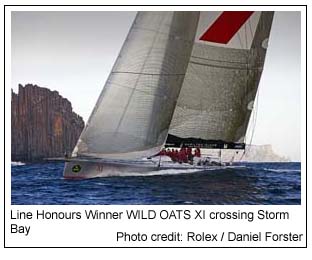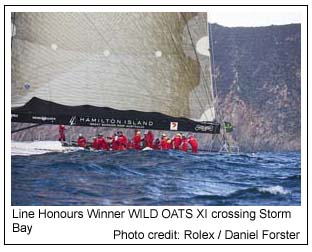|
Rolex Sydney Hobart Yacht Race
Sydney/Hobart, Australia
WILD OATS XI FIRST BOAT HOME
 What has been touted as one of the toughest Rolex Sydney Hobart Races in recent years, saw the first finisher arrive in Hobart early this evening. The 100-foot super maxi Wild Oats XI blazed up the Derwent River and crossed the finish line off Constitution Wharf at 2037 AEDT with an elapsed time of two days, seven hours, 37 minutes, 20 seconds -- since leaving Sydney Harbour at 1300 on 26 December, Boxing Day.
What has been touted as one of the toughest Rolex Sydney Hobart Races in recent years, saw the first finisher arrive in Hobart early this evening. The 100-foot super maxi Wild Oats XI blazed up the Derwent River and crossed the finish line off Constitution Wharf at 2037 AEDT with an elapsed time of two days, seven hours, 37 minutes, 20 seconds -- since leaving Sydney Harbour at 1300 on 26 December, Boxing Day.
This year’s 66th edition was one of Wild Oats Xl physically most difficult but also one of her more hard fought finishes, with sustained periods of headwinds along the way and crushing gale-force conditions through the notorious Bass Strait. In an interview as he stepped off the winning vessel, skipper Mark Richards said,” “It was a tough race, no doubt about that. The boat Wild Oats, the boys, and the team did a fantastic job.”
The Reichel-Pugh design was the provisional line honours winner pending the decision of the International Jury over a protest by the Race Committee regarding the use of her HF radio. The jury will convene Tuesday afternoon at the Royal Yacht Club of Tasmania to arrive at a decision.
 After sailing a near perfect tactical race in extremely difficult conditions, with extremes ranging from a hair-removing 25-40 knot southerly and a mountainous seaway during the first night, race favourite Wild Oats XI didn’t disappoint followers. This was Wild Oats XI fifth win after participating in six Rolex Sydney Hobart Races.
After sailing a near perfect tactical race in extremely difficult conditions, with extremes ranging from a hair-removing 25-40 knot southerly and a mountainous seaway during the first night, race favourite Wild Oats XI didn’t disappoint followers. This was Wild Oats XI fifth win after participating in six Rolex Sydney Hobart Races.
Wild Oats XI skipper Mark Richards was happy with the race and said, “We couldn’t have asked for a better result. To arrive here, first, in Hobart, is the most amazing feeling.” Referring to Oats’ second place finish of last year, Richards said, “First is hell of a lot better than second. We’re back and we’re just very happy to be here.”
Dockside after the race finish, Adrienne Cahalan co-navigator aboard Wild Oats XI and a veteran of now her 19th Rolex Sydney Hobart Race, commented on the extreme sea and wind, “I do think it’s one of the toughest races I’ve ever done. We did our best to make sure we didn’t break anything.”
A seasoned offshore sailor, Cahalan told of encountering 20 - 30 knot headwinds across the Bass Strait. As to how the boat managed, she said, “The boat held together really well…it was a technically sound race for us.” She continued, “To get there in one piece and in first place -- it’s one of the greatest victories we’ve had.”
The remaining 70 boats in the Rolex Sydney Hobart fleet are spread across from the southeast corner of the NSW coast, across the Bass Strait down towards the finish in Hobart -- pushed along by a 20-knot north-northeasterly. The fleet includes six international entries from the USA, UK, Italy, France, as well as two partly crewed Russian boats, and entries from seven of the eight Australian states and territories.
 Next boat expected across the finish line is Sean Langman’s 100-foot Investec Loyal at approximately 2230 tonight. However, breeze looks to be shutting down in the Derwent River, so their exact arrival is now anyone's guess.
Next boat expected across the finish line is Sean Langman’s 100-foot Investec Loyal at approximately 2230 tonight. However, breeze looks to be shutting down in the Derwent River, so their exact arrival is now anyone's guess.
In a phone interview earlier today, Investec Loyal’s Sean Langman explained about his boats’ troubles during the last two days, “The damage we sustained was to the reef lines earlier and some tack lines on the headsail which, running without a headsail, put us an hour back. Also, a fuel tank broke lose. These tanks carry so much fuel that you’ve got a quarter of a ton to manhandle which is difficult.”
On the final race day, Langman and crew discovered flooding in a forward hold, “We didn’t realize that we had a substantial leak in the bow and carried on with a ton and a half of water, which we only detected this morning. We have a watertight bulkhead up there and when we opened it, water came pouring out.” Langman believed that the leak was not a puncture in the hull but due to loose deck fittings.
The 2010 Rolex Sydney Hobart race may well go down as one of the roughest in recent years and has certainly lived up to its reputation as one of the world’s toughest ocean going races.
To date, 16 yachts have been forced to retire due to issues including a broken mast, damaged booms, rigging and engine problems. Almost all racers have their share of minor injuries due to the high seas and associated gale force winds.
TOP
|